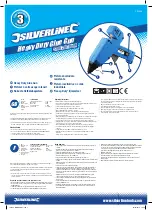
6 ENGLISH
6.
Do not use this nailer for fastening electrical
cables.
It is not designed for electric cable installa
-
tion and may damage the insulation of electric cables
thereby causing electric shock or fire hazards.
7.
Always wear safety glasses to protect your
eyes from dust or fastener injury.
WARNING: It is an employer's responsibility
to enforce the use of safety eye protection
equipment by the tool operators and by other
persons in the immediate working area.
8.
Keep hands and feet away from the ejection port area.
9.
Follow instruction for lubricating and chang-
ing accessories.
10.
Always remove the battery cartridge before
loading the fasteners, adjustment, inspection,
maintenance or after operation is over.
11.
Make sure no one is nearby before operation. Never
attempt to drive fasteners from both the inside and
outside of wall at the same time. Fasteners may rip
through and/or fly off, presenting a grave danger.
12.
Watch your footing and maintain your balance
with the tool. Make sure there is no one below
when working in high locations.
13.
Never use fastener driving tools marked with
the symbol "Do not use on scaffoldings, lad-
ders" for specific application for example:
•
when changing one driving location to another
involves the use of scaffoldings, stairs, ladders,
or ladder alike constructions, e.g. roof laths;
•
closing boxes or crates;
•
fitting transportation safety systems e.g. on
vehicles and wagons.
14.
Check walls, ceilings, floors, roofing and
the like carefully to avoid possible electrical
shock, gas leakage, explosions, etc. caused by
stapling into live wires, conduits or gas pipes.
15.
Use only fasteners specified in this manual. The use of
any other fasteners may cause malfunction of the tool.
16.
Do not tamper with the tool or attempt to use it
for other than driving fasteners.
17.
Do not operate the tool without fasteners. It
shortens the service life of the tool.
18.
Stop driving operations immediately if you notice
something wrong or out of the ordinary with the tool.
19.
Never fasten into any materials which may allow the
fastener to puncture and fly through as a projectile.
20.
Never actuate the switch trigger and contact
element at the same time until you are pre-
pared to fasten workpieces. Allow the work-
piece to depress the contact element. Never
defeat its purpose by securing the contact
element back or by depressing it by hand.
21.
Never tamper with the contact element. Check the
contact element frequently for proper operations.
22.
Always remove fasteners from the tool when
not in use.
SAVE THESE INSTRUCTIONS.
WARNING:
DO NOT let comfort or familiarity with
product (gained from repeated use) replace strict adher-
ence to safety rules for the subject product. MISUSE or
failure to follow the safety rules stated in this instruc-
tion manual may cause serious personal injury.
Important safety instructions for
battery cartridge
1.
Before using battery cartridge, read all instruc-
tions and cautionary markings on (1) battery
charger, (2) battery, and (3) product using battery.
2.
Do not disassemble battery cartridge.
3.
If operating time has become excessively
shorter, stop operating immediately. It may
result in a risk of overheating, possible burns
and even an explosion.
4.
If electrolyte gets into your eyes, rinse them out
with clear water and seek medical attention right
away. It may result in loss of your eyesight.
5.
Do not short the battery cartridge:
(1)
Do not touch the terminals with any con-
ductive material.
(2)
Avoid storing battery cartridge in a container
with other metal objects such as nails, coins, etc.
(3)
Do not expose battery cartridge to water or rain.
A battery short can cause a large current flow, over
-
heating, possible burns and even a breakdown.
6.
Do not store the tool and battery cartridge in
locations where the temperature may reach or
exceed 50 °C (122 °F).
7.
Do not incinerate the battery cartridge even if
it is severely damaged or is completely worn
out. The battery cartridge can explode in a fire.
8.
Be careful not to drop or strike battery.
9.
Do not use a damaged battery.
10.
The contained lithium-ion batteries are subject to
the Dangerous Goods Legislation requirements.
For commercial transports e.g. by third parties,
forwarding agents, special requirement on pack
-
aging and labeling must be observed.
For preparation of the item being shipped, consult
-
ing an expert for hazardous material is required.
Please also observe possibly more detailed
national regulations.
Tape or mask off open contacts and pack up the
battery in such a manner that it cannot move
around in the packaging.
11.
Follow your local regulations relating to dis-
posal of battery.
SAVE THESE INSTRUCTIONS.
CAUTION:
Only use genuine Makita batteries.
Use of non-genuine Makita batteries, or batteries that
have been altered, may result in the battery bursting
causing fires, personal injury and damage. It will also
void the Makita warranty for the Makita tool and charger.
Tips for maintaining maximum
battery life
1.
Charge the battery cartridge before completely dis-
charged. Always stop tool operation and charge the
battery cartridge when you notice less tool power.
2.
Never recharge a fully charged battery cartridge.
Overcharging shortens the battery service life.
3.
Charge the battery cartridge with room tempera-
ture at 10 °C - 40 °C (50 °F - 104 °F). Let a hot
battery cartridge cool down before charging it.







































